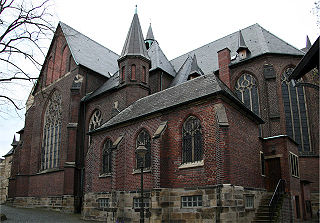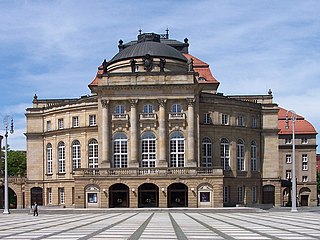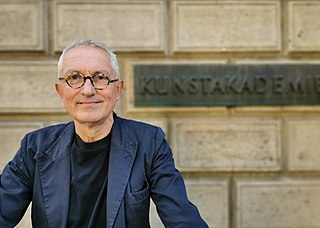
Essen is the central and, after Dortmund, second-largest city of the Ruhr, the largest urban area in Germany. Its population of 579,432 makes it the fourth-largest city of North Rhine-Westphalia after Cologne, Düsseldorf and Dortmund, as well as the ninth-largest city of Germany. Essen lies in the larger Rhine-Ruhr metropolitan region, second largest by GDP in the EU, and is part of the cultural area of Rhineland. Because of its central location in the Ruhr, Essen is often regarded as the Ruhr's "secret capital". Two rivers flow through the city: the Emscher in the north, and in the south the Ruhr River, which is dammed in Essen to form the Lake Baldeney (Baldeneysee) and Lake Kettwig reservoirs. The central and northern boroughs of Essen historically belong to the Low German (Westphalian) language area, and the south of the city to the Low Franconian Bergish area.

Hamm is a city in North Rhine-Westphalia, Germany. It is located in the northeastern part of the Ruhr area. As of 2016 its population was 179,397. The city is situated between the A1 motorway and A2 motorway. Hamm railway station is an important hub for rail transport and renowned for its distinctive station building.

Bitterfeld is a town in the district of Anhalt-Bitterfeld, Saxony-Anhalt, Germany. Since 1 July 2007 it has been part of the town of Bitterfeld-Wolfen. It is situated approximately 25 km south of Dessau, and 30 km northeast of Halle (Saale). At the end of 2016, it had 40,964 inhabitants.

Wattenscheid is a Stadtbezirk of the city of Bochum. Until 1975, it was a separate town in the Ruhr area of North Rhine-Westphalia. Wattenscheid has a population of about 80,000 citizens. Some notable firms have their headquarters in there, such as Steilmann.

Castrop-Rauxel, often simply referred to as Castrop by locals, is a former coal mining city in the eastern part of the Ruhr Area within the state of North Rhine-Westphalia in Germany.

Waltrop (German pronunciation:[ˈvaltʁɔp] is a town in the district of Recklinghausen, in North Rhine-Westphalia, Germany. It is situated on the Datteln-Hamm Canal, approximately 15 km east of Recklinghausen and 15 km north-west of Dortmund.

Herten is a town and a municipality in the district of Recklinghausen, in North Rhine-Westphalia, Germany. It is situated in the industrial Ruhr Area, some 5 km (3.1 mi) west of Recklinghausen.

Selm is a town in the district of Unna, in North Rhine-Westphalia, Germany. It is situated approximately 20 kilometers north of Dortmund and 25 kilometers west of Hamm.

The Rhine–Herne Canal is a 45.6-kilometre-long (28.3 mi) transportation canal in the Ruhr area of North Rhine-Westphalia, Germany, with five canal locks. The canal was built over a period of eight years and connects the harbour in Duisburg on the Rhine with the Dortmund-Ems Canal near Henrichenburg, following the valley of the Emscher. It was widened in the 1980s. The Rhein-Herne canal ship was designed specifically for this canal; normally of about 1300–1350 ton capacity, it has a maximum draft of 2.50 metres (8.2 ft), a length of approximately 80 metres (260 ft), and maximum beam of 9.50 metres (31.2 ft).
Alfred Fischer was a German architect.

The Industrial Heritage Trail links tourist attractions related to the industrial heritage in the Ruhr area in Germany. It is a part of the European Route of Industrial Heritage. The series of routes were developed between 1989 and 1999, however additions are still being made.

Zeche Carl is a cultural centre set up by Essen Council in a former coal mine.
SC Eintracht Hamm was a German association football club from the town of Hamm, North Rhine-Westphalia. The club's greatest success has been its two championships in the tier three Oberliga Westfalen in 1982–83, 1984–85. This entitled the club to, unsuccessfully, take part in the promotion round to the 2. Bundesliga in 1983 and 1985.

Frank Beermann is a German conductor. He was Generalmusikdirektor (GMD) at the Chemnitz Opera for several years, and has worked freelance at international opera houses from 2012. He has conducted premieres and recordings of rarely performed operas and orchestral works.
Dara Kristin Hobbs is an American operatic soprano, who has appeared internationally, mostly in European opera houses. Her repertoire has focused on dramatic soprano roles, such as Wagner's Isolde and Strauss' Ariadne. She appeared as Wagner's Brünnhilde in Der Ring in Minden.
Thomas Mohr is a German operatic tenor and academic voice teacher. He began his career as a baritone, but moved on to heldentenor and has performed roles in all tenor parts of Wagner's Der Ring des Nibelungen at Der Ring in Minden. He has appeared at major international opera houses and concert halls, and made recordings. Mohr is a professor of voice at the Hochschule für Künste Bremen. He also runs an agricultural estate where he founded a music festival.
Tijl Faveyts is a Belgian operatic bass. A current member of the Komische Oper Berlin, he has performed leading roles such as Mozart's Sarastro and Hunding in Wagner's Die Walküre and Gurnemanz Parsifal at major opera houses, concert halls and festivals, and made recordings.
Heiko Trinsinger is a German operatic baritone. A member of the Aalto Theatre in Essen, he has performed leading roles at major houses, such as Mozart's Papageno and Wagner's Alberich.
Julia Bauer is a German operatic coloratura soprano who has appeared at major opera houses and also in concert and recital. She has had leading roles such as Zerbinetta and Lulu, and was Freia, Helmwige, Forest Bird, Woglinde and Third Norn in Der Ring in Minden.

Karl-Heinz Petzinka is a German architect, and Rector of the Kunstakademie Düsseldorf. He is known for office buildings in Düsseldorf and Berlin. He converted historic industrial buildings, and was responsible for the section architecture for the Ruhr.2010 project.















